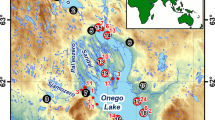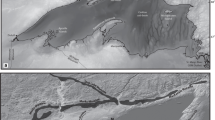Abstract
This study reviews Glacial Lake Algonquin, examines the Main and two “Upper Group” phases in northern Michigan and nearby Ontario, reports their spatial extents, and reassesses the lake history in light of isostatic rebound. Our paper presents the most accurate and detailed maps of Glacial Lake Algonquin in this region that have yet been published. Fieldwork was conducted at 243 ancient shoreline sites, which yielded position data that support geostatistical models that represent differentially upwarped water planes. Model parameters that describe water plane tilt are reported for the Main, Ardtrea and Upper Orillia phases. Geostatistical water plane models were used to adjust a digital contemporary elevation model, thereby creating a digital proglacial elevation model for each phase. Maps of these phases and the data that support them suggest (1) proto-Cockburn Island, Ontario existed as an islet in the lake that was deglaciated before the outlet at North Bay, Ontario was opened, (2) the Main and Ardtrea phases of the lake extended into the northern Lake Michigan basin, and (3) the Main and Ardtrea water planes intersect at places near Little Traverse Bay (by Lake Michigan) and Thunder Bay (by Lake Huron). Mapped isobases generally conform to those published in other works and suggest the regional pattern of isostatic adjustment has not changed substantially during the last 13,000 years.






Similar content being viewed by others
References
Bailey TC, Gatrell AC (1995) Interactive spatial data analysis. Longman Group Limited, Essex
Broecker WS, Farrand WR (1963) Radiocarbon age of the Two Creeks forest bed, Wisconsin. Geol Soc Am Bull 74:795–802
Burrough PA, McDonnell RA (1998) Principles of geographical information systems. Oxford University Press, Oxford
Capps DK, Thompson TA, Booth RK (2007) A post-Calumet shoreline along southern Lake Michigan. J Paleolimnol 37(3):395–409
Chapman LJ, Putnam DF (1966) The physiography of Southern Ontario, 2nd edn. University of Toronto Press, Toronto
Clark RH, Persoage NP (1970) Some implications of crustal movement in engineering planning. Can J Earth Sci 7(2):628–633
Clark JA, Hendriks M, Timmermans TJ, Struck C, Hilverda KJ (1994) Glacial isostatic deformation of the Great Lakes region. Geol Soc Am Bull 106(1):19–31
Clark JA, Zylstra DJ, Befus KM (2007) Effects of Great Lakes water loading upon glacial isostatic adjustment and lake history. J Great Lakes Res 33(3):627–641
Coordinating Committee on Great Lakes Basic Hydraulic and Hydrologic Data (1977) Apparent vertical movement over the Great Lakes. Chicago, Illinois, U.S. Army Corps of Engineers, and Cornwall, Ontario, Environment Canada
Coordinating Committee on Great Lakes Basic Hydraulic and Hydrologic Data (2001) Apparent vertical movement over the Great Lakes: Revisited. Chicago, Illinois, U.S. Army Corps of Engineers, and Cornwall, Ontario, Environment Canada
Cowan WR (1985) Deglacial Great Lakes shorelines at Sault Ste. Marie, Ontario. In: Karrow PF, Calkin P (eds) Quaternary Evolution of the Great Lakes. Geological Association of Canada, St. Johns, Newfoundland, Special paper 30, pp 33–37
Curry B, Petras J (2011) Chronological framework for the deglaciation of the Lake Michigan lobe of the Laurentide Ice Sheet from ice-walled lake deposits. J Quat Sci 26(4):402–410
Deane RE (1950) Pleistocene geology of the Lake Simcoe district, Ontario. Geol Surv Can Memoir 256, 108 pp
Dietrich RV (1978) Post-Valders geological history of Beaver Island, Michigan. Mich Acad 10(3):283–297
Drzyzga SA (2007a) Relict shoreline features at Cockburn Island, Ontario. J Paleolimnol 37(3):411–417
Drzyzga SA (2007b) Mapping and modeling Glacial Lake Algonquin in Northern Michigan and Western Ontario with models of uncertainty. Doctoral Dissertation, Michigan State University, East Lansing
Drzyzga SA, Shortridge A, Schaetzl RJ (2002) Revealing uncertainty in maps of Glacial Lake Algonquin. In: Richardson D, van Oosterom P (eds) Advances in spatial data handling. Springer, Berlin, pp 377–390
Fairbanks RG, Mortlock RA, Chiu TC, Cao L, Kaplan A, Guilderson TP, Fairbanks TW, Bloom AL (2005) Marine radiocarbon calibration curve spanning 0 to 50, 000 years BP based on paired 230Th/234U and 14C dates on pristine corals. Quat Sci Rev 24(16–17):1781–1796
Farrand WR, Drexler CW (1985) Late Wisconsinan and Holocene history of the Lake Superior basin. In: Karrow PF, Calkin P (eds) Quaternary Evolution of the Great Lakes. Geological Association of Canada, St. Johns, Newfoundland, Special paper 30, pp 17–32
Finamore PF (1985) Glacial Lake Algonquin and the Fenelon Falls outlet. In: Karrow PF, Calkin P (eds) Quaternary Evolution of the Great Lakes. Geological Association of Canada, St. Johns, Newfoundland, Special paper 30, pp 127–132
Futyma RP (1981) The northern limits of Glacial Lake Algonquin in upper Michigan. Quat Res 15(3):291–310
Gilbert GK (1898) Recent earth movements in the Great Lakes region. United States geological survey 18th annual report, Part 2, pp 601–647
Goldthwait JW (1908) A reconstruction of water planes of the extinct Glacial Lakes in the Michigan basin. J Geol 16:459–476
Goldthwait JW (1910) An instrumental survey of the shore-lines of the extinct Lakes Algonquin and Nipissing in southwestern Ontario. Can Geol Surv, Branch Memoir 10:1–57
Hansel AK, Mickelson DM (1988) A reevaluation of the timing and causes of high lake phases in the Lake Michigan basin. Quat Res 29(2):113–128
Hansel AK, Mickelson DM, Schneider AF, Larsen CE (1985) Late Wisconsinan and Holocene history of the Lake Michigan basin. In: Karrow PF, Calkin P (eds) Quaternary Evolution of the Great Lakes. Geological Association of Canada, St. Johns, Newfoundland, Special paper 30, pp 39–53
Harrison JE (1972) Quaternary geology of the North Bay-Mattawa region. Geol Surv Can, Ottawa, Paper 71-26, p 37
Heath AJ, Karrow PJ (2007) Northernmost (?) Glacial Lake Algonquin series shorelines, Sudbury basin, Ontario. J Great Lakes Res 33(1):264–278
Hough JL (1958) Geology of the Great Lakes. University Illinois Press, Urbana
Hough JL (1963) The prehistoric Great Lakes of North America. Am Sci 51(1):84–109
Kaiser KF (1994) Growth rings as indicators of glacier advances, surges and floods. Dendrochronologia (Verona) 11:101–122
Karrow PF (1986) Valley terraces and Lake Algonquin shoreline position, southeast shore of Lake Huron, Canada. J Great Lakes Res 12(2):132–135
Karrow PF (1987) Glacial and glaciolacustrine events in northwestern Lake Huron, Michigan and Ontario. Geol Soc Am Bull 98(1):113–120
Karrow PF (1988) The Lake Algonquin shoreline, Kincardine-Port Elgin, Ontario. Can J Earth Sci 25(1):157–162
Karrow PF (2004) Algonquin-Nipissing shorelines, North Bay, Ontario. Géographie physique et Quaternaire 58(2–3):297–304
Karrow PF, Anderson TW, Clarke AH, Delorme LD, Sreenivasa MR (1975) Stratigraphy, paleontology, and age of Lake Algonquin sediments in southwestern Ontario, Canada. Quat Res 5(1):49–87
Kincare K, Larson GJ (2002) Surficial geology of Northern Leelanau County; Michigan geological survey [map: nominal scale 1:100,000], Open file report 2002-3, State of Michigan Geol Surv, Lansing
Kincare K, Larson GJ (2009) Evolution of the Great Lakes. In: Schaetzl RJ, Darden JT, Brandt D (eds) Michigan geography and geology. Pearson Custom Publishing, Boston, pp 174–190
Krist F, Schaetzl RJ (2001) Paleowind (11, 000 BP) directions derived from lake spits in Northern Michigan. Geomorphology 38(1–2):1–18
Larsen CE (1987) Geological history of Glacial Lake Algonquin and the upper Great Lakes. United States Geol Surv Bull 1801:36
Larson GJ, Schaetzl RJ (2001) Origin and evolution of the Great Lakes. J Great Lakes Res 27:518–546
Lawson AC (1891) Sketch of the coastal topography of the north side of Lake Superior with special reference to the abandoned strands of Lake Warren (the greatest of the late Quaternary lakes of North America). In: Winchell NH (ed) The geological and natural history survey of Minnesota, the twentieth-annual report for the year 1891. The Geological and Natural History Survey, Minnnesota, Minneapolis, pp 183–289
Leverett F (1913) Notes concerning the features of St. Joseph Island, Lake Huron, Ontario. Geol Surv Can, summary report of the Geol Surv, Sessional paper 26, pp 271–274
Leverett F, Taylor FB (1915) The Pleistocene of Indiana and Michigan and the history of the Great Lakes. United States Geol Surv Mon 53:529
Leverington DW, Teller JT, Mann JD (2002) A GIS method for reconstruction of late Quaternary landscapes from isobase data and modern topography. Comput Geosci 28(5):631–639
Lewis CFM, Blasco SM, Gareau PL (2005) Glacial isostatic adjustment of the Laurentian Great Lakes Basin: Using the empirical record of strandline deformation for reconstruction of early Holocene Paleo-lakes and discovery of a hydrologically closed phase. Geogr Phys Quat 59(2–3):187–210
Mainville A, Craymer MR (2005) Present-day tilting of the Great Lakes region based on water level gauges. Geol Soc Am Bull 117(7–8):1070–1080
Roman DR, Wang YM, Henning W, Hamilton J (2004) Assessment of the new national geoid height model, GEOID03. 2004 ACSM/TAPS Conference and Technology Exhibition, Nashville, TN, pp 14. Available online: http://www.ngs.noaa.gov/GEOID/geolib.html (Last viewed on 6 Sept 2011)
Schaetzl RJ, Drzyzga SA, Weisenborn BN, Kincare KA, Lepczyk XC, Shein KA, Dowd CM, Linker J (2002) Measurement, correlation, and mapping of Glacial Lake Algonquin shorelines in northern Michigan. Ann Assoc Am Geog 92(3):399–415
Sly PG, Lewis CFM (1972) The Great Lakes of Canada—Quaternary geology and limnology. In: International Geological Congress 24th Field Excursion A43 Guidebook
Snay RA, Soler T (2008) Continuously operating reference station (CORS): history, applications, and future enhancements. J Surv Eng 134(4):95–104
Spencer JW (1888) The St. Lawrence Basin and the Great Lakes. Proc Am Assoc Adv Sci (Abstract) 37:197–199
Spencer JW (1891) Deformation of the Algonquin beach and birth of Lake Huron. Am J Sci 41(241):11–21
Stanley GM (1936) Lower Algonquin beaches of the Penetanguishene Peninsula. Geol Soc Am Bull 47(12):1933–1960
Stanley GM (1937) Lower Algonquin beaches at Cape Rich, Georgian Bay. Geol Soc Am Bull 48(11):1665–1686
Stanley GM (1945) Pre-historic Mackinac Island. Mich Geol Sur Pub 43, Geol Ser 36, 74 pp
Taylor FB (1894) A reconnaissance of the abandoned shore lines of the south coast of Lake Superior. Am Geol 13:365–383
Taylor FB (1895) The Munuscong Islands. Am Geol 15:24–33
Tushingham AM, Peltier WR (1991) ICE-3G: a new global model of late Pleistocene deglaciation based upon geophysical predictions of post-glacial relative sea level change. J Geophys Res 96(B3):4497–4523
Acknowledgments
Funding for fieldwork was provided by the Association of American Geographers via a Doctoral Dissertation Improvement Grant and the Department of Geography at Michigan State University via a Graduate Research Fellowship. We thank Mr. L. Avra, of the Huron Timber Company of Thessalon, Ontario, for our work at Cockburn Island would not have been possible without his permission and assistance. We extend gratitude and thanks to Drs. P. F. Karrow, W. R. Cowan, C. F. M. Lewis, and K. Kincare for sharing data and insights regarding GLA. We also thank Dr. Alan Arbogast, Dr. Grahame Larson, Cathy Dowd, Rick and Janis Herman and Beth Weisenborn for their meaningful contributions.
Author information
Authors and Affiliations
Corresponding author
Electronic supplementary material
Below is the link to the electronic supplementary material.
Rights and permissions
About this article
Cite this article
Drzyzga, S.A., Shortridge, A.M. & Schaetzl, R.J. Mapping the phases of Glacial Lake Algonquin in the upper Great Lakes region, Canada and USA, using a geostatistical isostatic rebound model. J Paleolimnol 47, 357–371 (2012). https://doi.org/10.1007/s10933-011-9550-9
Received:
Accepted:
Published:
Issue Date:
DOI: https://doi.org/10.1007/s10933-011-9550-9




